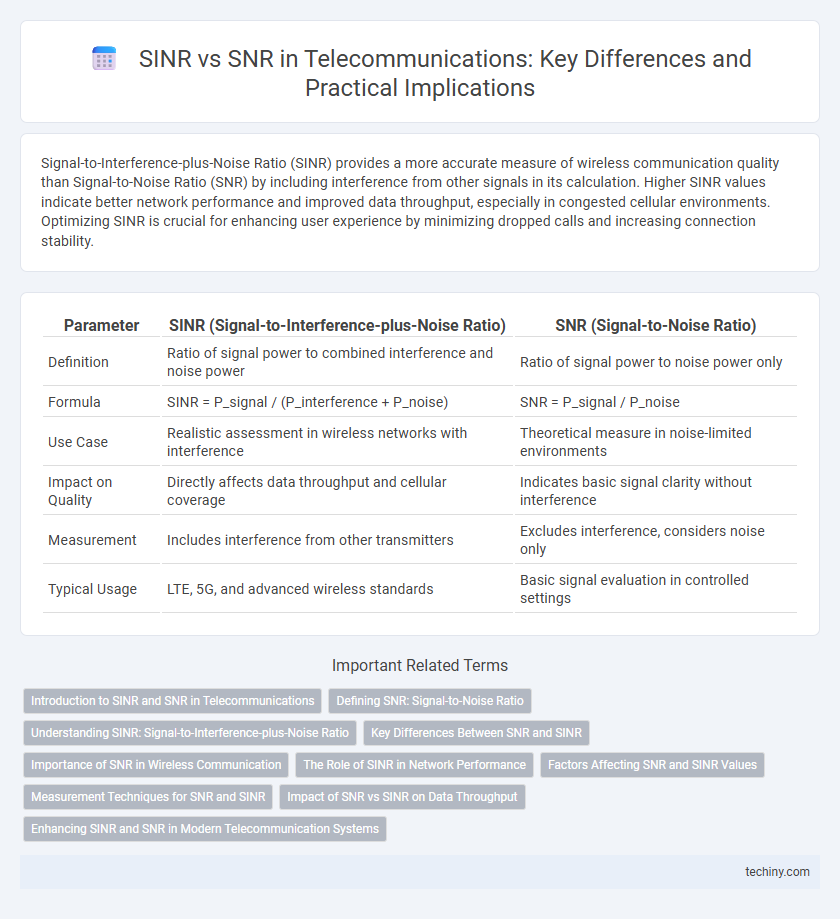Signal-to-Interference-plus-Noise Ratio (SINR) provides a more accurate measure of wireless communication quality than Signal-to-Noise Ratio (SNR) by including interference from other signals in its calculation. Higher SINR values indicate better network performance and improved data throughput, especially in congested cellular environments. Optimizing SINR is crucial for enhancing user experience by minimizing dropped calls and increasing connection stability.
Table of Comparison
| Parameter | SINR (Signal-to-Interference-plus-Noise Ratio) | SNR (Signal-to-Noise Ratio) |
|---|---|---|
| Definition | Ratio of signal power to combined interference and noise power | Ratio of signal power to noise power only |
| Formula | SINR = P_signal / (P_interference + P_noise) | SNR = P_signal / P_noise |
| Use Case | Realistic assessment in wireless networks with interference | Theoretical measure in noise-limited environments |
| Impact on Quality | Directly affects data throughput and cellular coverage | Indicates basic signal clarity without interference |
| Measurement | Includes interference from other transmitters | Excludes interference, considers noise only |
| Typical Usage | LTE, 5G, and advanced wireless standards | Basic signal evaluation in controlled settings |
Introduction to SINR and SNR in Telecommunications
Signal-to-Noise Ratio (SNR) measures the power ratio between a signal and background noise, essential for evaluating basic signal quality in telecommunications. Signal-to-Interference-plus-Noise Ratio (SINR) extends this concept by including interference from other signals, providing a more comprehensive assessment of network performance in congested wireless environments. Accurate SINR measurement is critical for optimizing resource allocation and improving data throughput in modern cellular networks.
Defining SNR: Signal-to-Noise Ratio
Signal-to-Noise Ratio (SNR) quantifies the level of desired signal power relative to background noise power in a telecommunications system. It is expressed in decibels (dB) and serves as a critical parameter for assessing the quality of wireless communication links. Higher SNR values indicate clearer signal reception and improved data transmission reliability.
Understanding SINR: Signal-to-Interference-plus-Noise Ratio
SINR (Signal-to-Interference-plus-Noise Ratio) measures the quality of a wireless communication signal by comparing the power of the desired signal to the combined power of interference and background noise. Unlike SNR (Signal-to-Noise Ratio), which only accounts for noise, SINR includes interference from other transmitters, making it a more comprehensive metric for evaluating network performance in dense cellular environments. Optimizing SINR directly impacts data throughput and connection reliability in LTE, 5G NR, and Wi-Fi networks.
Key Differences Between SNR and SINR
Signal-to-Noise Ratio (SNR) measures the power ratio between the desired signal and background noise, while Signal-to-Interference-plus-Noise Ratio (SINR) accounts for both noise and interference from other transmitters, providing a more comprehensive assessment in dense network environments. SNR is primarily used in isolated scenarios with negligible interference, whereas SINR is critical in multi-user or spectrum-sharing contexts where interference significantly impacts communication quality. Accurate SINR measurement enables better resource allocation and robust modulation schemes, enhancing overall network performance compared to reliance on SNR alone.
Importance of SNR in Wireless Communication
Signal-to-Noise Ratio (SNR) is crucial in wireless communication as it directly impacts the clarity and reliability of signal transmission by comparing the level of the desired signal to background noise. A higher SNR means better signal quality, resulting in fewer errors, enhanced data rates, and improved overall network performance. Unlike Signal-to-Interference-plus-Noise Ratio (SINR), which accounts for both interference and noise, SNR specifically measures noise impact, making it fundamental for modulation schemes and error correction techniques in wireless systems.
The Role of SINR in Network Performance
SINR (Signal to Interference plus Noise Ratio) is a critical metric in telecommunications that directly impacts network performance by measuring the quality of a wireless signal against both interference and noise. Unlike SNR (Signal to Noise Ratio), which only considers noise, SINR provides a more comprehensive assessment by incorporating interference from other users or devices, making it a key factor in optimizing data throughput and connection reliability. High SINR values facilitate better modulation schemes and higher data rates, ultimately improving user experience and overall network capacity.
Factors Affecting SNR and SINR Values
Signal-to-Noise Ratio (SNR) and Signal-to-Interference-plus-Noise Ratio (SINR) values are influenced by various factors such as transmission power, distance between transmitter and receiver, and environmental noise levels. Interference from neighboring cells or devices significantly impacts SINR, while SNR primarily depends on inherent thermal noise and receiver sensitivity. Multipath fading, physical obstructions, and antenna design also play critical roles in determining both SNR and SINR in wireless communication systems.
Measurement Techniques for SNR and SINR
Measurement techniques for SNR involve capturing the ratio of signal power to noise power by analyzing the received signal waveform with spectrum analyzers or specialized test equipment under controlled noise conditions. SINR measurement requires evaluating the ratio of signal power to interference plus noise power, often using advanced algorithms in interference-limited environments, such as cellular networks, to account for adjacent channel interference. Accurate SINR assessment relies on real-time signal processing tools and spatial filtering methods to isolate interference sources, providing a more precise quality indicator than traditional SNR metrics in modern wireless systems.
Impact of SNR vs SINR on Data Throughput
Signal-to-Interference-plus-Noise Ratio (SINR) provides a more accurate representation of the wireless communication environment by accounting for both interference and noise, directly influencing data throughput and link reliability. Unlike Signal-to-Noise Ratio (SNR), which only measures pure noise, SINR determines the effective modulation and coding scheme, thereby optimizing spectral efficiency and maximizing throughput under varying network conditions. Higher SINR values enable better channel capacity and lower error rates, crucial for maintaining high data rates in congested or interference-prone telecommunications systems.
Enhancing SINR and SNR in Modern Telecommunication Systems
Enhancing Signal-to-Interference-plus-Noise Ratio (SINR) and Signal-to-Noise Ratio (SNR) is crucial for optimizing data throughput and connection reliability in modern telecommunication systems. Techniques such as advanced beamforming, adaptive modulation, and interference cancellation significantly improve SINR by mitigating co-channel interference while improving SNR through noise reduction and signal amplification. Leveraging 5G NR technologies, massive MIMO arrays, and dynamic spectrum allocation further enhances these metrics, ensuring high-quality wireless communication in dense and heterogeneous network environments.
SINR vs SNR Infographic

 techiny.com
techiny.com